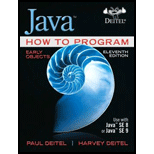
Concept explainers
Fill in the blanks in each of the following statements:
Typically, statements are used for counter-controlled
iteration and statements for sentinel-controlled iteration.
The “for loop” statements are used for counter-controlled iteration and “while loop” statements used for sentinel-controlled iteration.
Explanation of Solution
“for” loop:
- The for loop gets starts with the keyword “for”. It contains three control structures and these control structures are separated using (;) semicolon. They are:
- “Initial-action”, used to initialize the control variable.
- “Loop-continuation-condition”, it determines whether the loop gets repeated.
- “Action-after-each-iteration”, used to update the control variable for next iteration.
- So, the “for” loop always used for counter-controlled iteration.
A for loop is used to execute a block of statements repeatedly until the condition is true. The syntax of for loop:
for(i=initial_value;i<end_value;i++)
{
Loop statements;
}
- Here, the variable “i” is referred as control variable, it controls how many times that the loop gets executed.
“while” loop:
The “while” loop first checks its expression and then the statements inside the loop are executed. It is also called as pretest loops.
- These loops do not have to be terminated with a semicolon.
- With the false expressions, the loops can be terminated.
- So, the “while” loop always used for sentinel-controlled iteration.
Syntax:
The syntax for the while loop is as follows:
//while loop statement
while (condition)
{
//statement
}
Want to see more full solutions like this?
Chapter 5 Solutions
Java How to Program, Early Objects (11th Edition) (Deitel: How to Program)
- Which of the following statements are equivalent? Which ones are correctly indented?arrow_forwardFind the error in the given statements then write the correct statements.arrow_forward2. What is the truth value of each of the following statements? 8 is even and 6 is odd If 8 is odd and 6 is even, then 8 < 6.arrow_forward
- Fill in the blanks to rewrite the following statement with variables: “Is there an integer with a remainder of 1 when it is divided by 4 and a remainder of 3 when it is divided by 7?” (a) Is there an integer n such that n has ____________ ? (b) Does there exist ___________ such that if n is divided by 4 the remainder is 1 and if ___________?arrow_forwardRewrite the following statements using combined assignment operators: length = length / 2;arrow_forwardFill in the blanks to rewrite the following statement with variables: “Given any positive real number, there is a positive real number that is smaller.” (a) Given any positive real number r, there is _____________ s such that s is ___________ . (b) For any _________ , __________ such that s < rarrow_forward
 C++ Programming: From Problem Analysis to Program...Computer ScienceISBN:9781337102087Author:D. S. MalikPublisher:Cengage Learning
C++ Programming: From Problem Analysis to Program...Computer ScienceISBN:9781337102087Author:D. S. MalikPublisher:Cengage Learning C++ for Engineers and ScientistsComputer ScienceISBN:9781133187844Author:Bronson, Gary J.Publisher:Course Technology Ptr
C++ for Engineers and ScientistsComputer ScienceISBN:9781133187844Author:Bronson, Gary J.Publisher:Course Technology Ptr Microsoft Visual C#Computer ScienceISBN:9781337102100Author:Joyce, Farrell.Publisher:Cengage Learning,
Microsoft Visual C#Computer ScienceISBN:9781337102100Author:Joyce, Farrell.Publisher:Cengage Learning,


